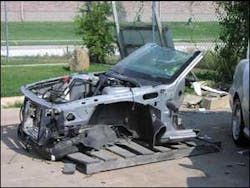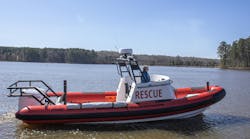Stories still circulate about fuel lines, electric lines, brake lines and all kinds of lines running inside a rocker channel. The report is that when you cut a rocker, you'll cause a fuel leak to occur.
Topic: Rocker Channel Cut-Away
The rocker channel is the hollow tubular-type shaped metal part of a vehicle that runs from the base of the A-pillar, along the outer edge of the floorpan, to the base of the B- and C-pillars. In a uni-body construction vehicle such as a typical passenger automobile, it actually serves as part of the structural elements of the vehicle.
Stories still circulate about fuel lines, electric lines, brake lines and all kinds of lines running inside a rocker channel. The report is that when you cut a rocker, you'll cause a fuel leak to occur. This Crash Course drill is designed to help you understand what a rocker channel consists of and to establish policy and procedures anytime a rocker channel must be cut at an extrication scene.
Photo 1: Visually inspecting what is called a 'front clip', the entire structural front end of a vehicle from the base of the A-pillar forward, that was located at a body repair shop, we are able to discuss what really runs 'inside' a rocker and compare that to what runs on or near the rocker.
Photo 2: A cross-section view of the rocker on the passenger's side of this front clip shows the multiple layers of sheetmetal that make up the rocker channel structure. An outer piece of sheetmetal is folded into a C-shape and spot welded to the end of the flat floorpan to form a hollow tube. An additional piece of sheetmetal is folded inside the channel to add strength and stability to the structure.
Note, however, that there are no lines or wires running inside the rocker. All the wires, fuel lines, electric cables and such that are positioned in this area either run on top of the rocker or underneath it. In this actual case, the end of the large wiring harness bundle is visible sitting underneath the grey carpeting just to the left of the rocker. Door weatherstripping, insulation, and carpeting all are placed on or in close proximity to the rocker channel in a finished vehicle.
Photo 3: Why then do stories of cutting the rocker with a rescue tool causing a fuel leak always come up? The reason is that when extrication crews cut into or through a rocker, they typically sever the wiring and the steel tubular lines that lay next to, on top of or underneath the rocker. It's not that these liquid lines are inside the rocker; they're just near it.
Photo 4: Even on a full-frame vehicle such as this Chevy Suburban being repaired at a collision shop, the rocker channel is similar to that of uni-body automobiles. In this case, all the wiring will run above the rocker and all the brake and fuel lines will run underneath it. The rocker itself is hollow and empty.
Anticipate cutting of wires and severing of liquid-filled fuel lines or brake lines any time you cut into or through a rocker. This is especially true when working on a uni-body construction vehicle. Have the electricity shut down and absorbent material readily available to properly manage the spillage that will occur. It's just one of the many calculated risks we take at a crash scene.
Crash Course Teaching Point:
If you have to cut a rocker, do it. But just don't be caught off guard by any unexpected surprises.
Be Informed...Be Ready...Beware!






